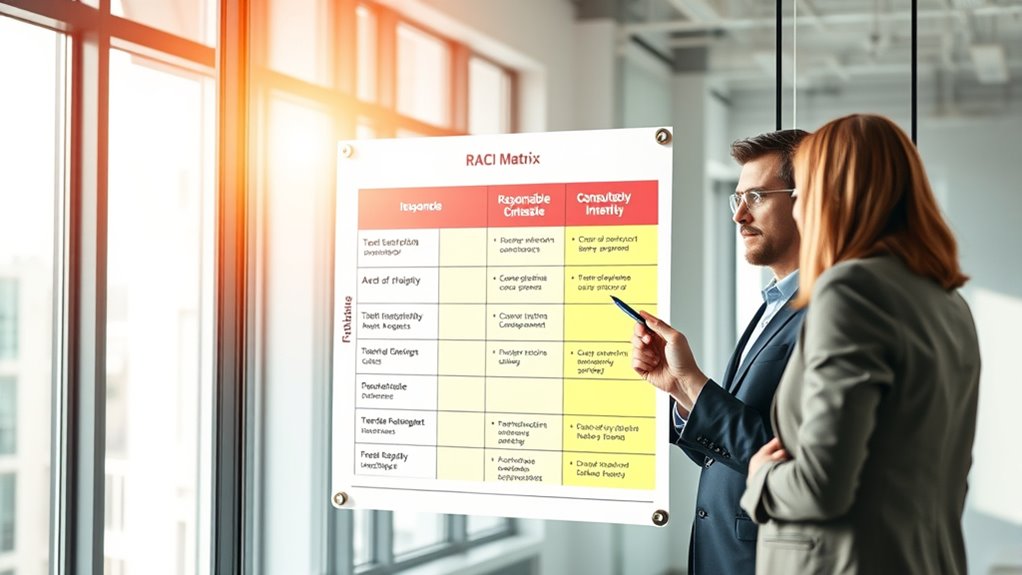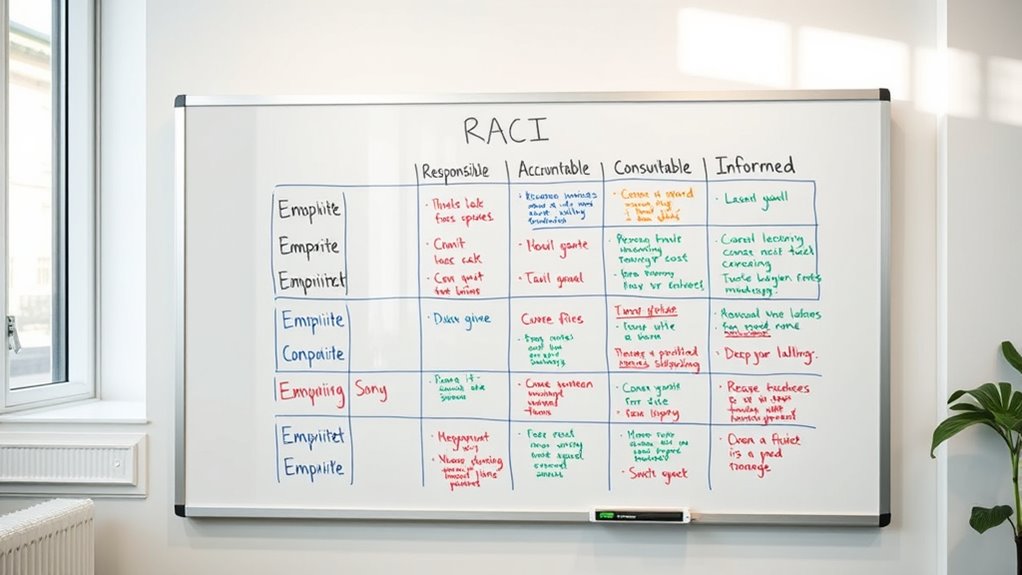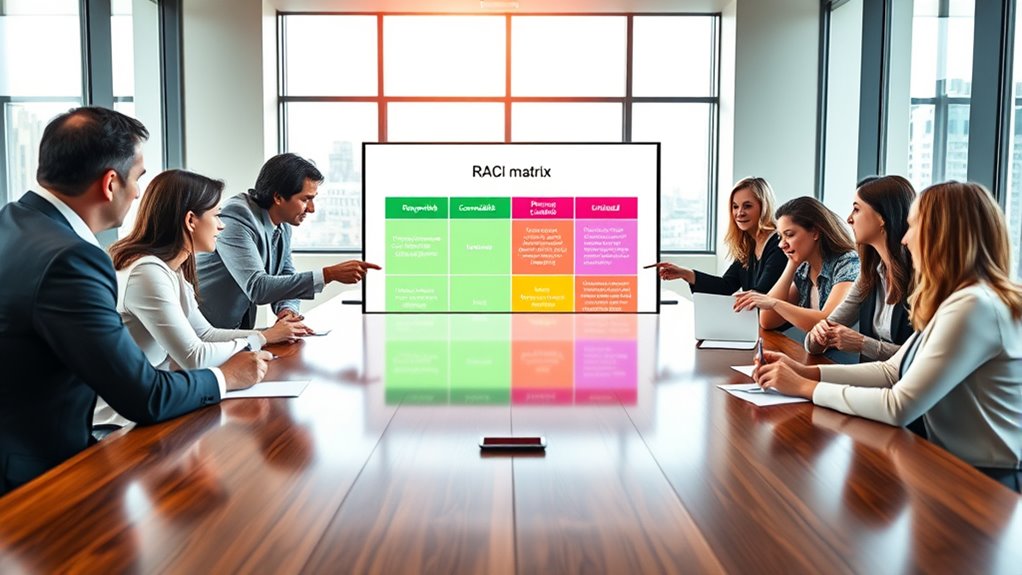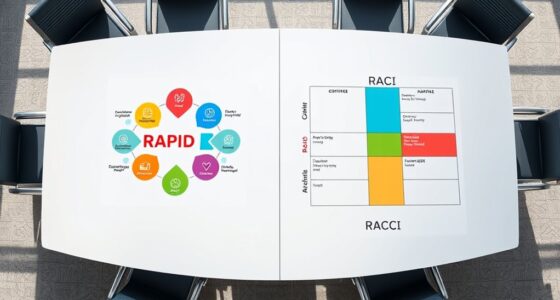A RACI matrix helps you clarify roles and responsibilities in your projects, ensuring everyone understands their part. It defines who is Responsible, Accountable, Consulted, and Informed for each task, promoting transparency and efficiency. Using a RACI chart streamlines decision-making, reduces confusion, and improves team collaboration. By establishing clear roles early on, you can avoid common mistakes and boost project success. Keep exploring to uncover how to create and maintain an effective RACI matrix.
Key Takeaways
- The RACI matrix defines clear roles: Responsible, Accountable, Consulted, and Informed, for each project task.
- It helps clarify responsibilities, prevent overlaps, and ensure accountability within teams.
- Creating and maintaining a RACI chart involves identifying tasks, assigning roles, and regularly updating roles.
- It promotes effective communication, transparency, and stakeholder engagement throughout project execution.
- Common challenges include role overload, ambiguity, and outdated roles, which require careful management and review.
Understanding the RACI Framework

Have you ever wondered how teams coordinate to complete complex projects efficiently? The RACI framework helps clarify roles and responsibilities, ensuring everyone knows their part. Central to this is effective stakeholder engagement, which keeps all parties informed and involved. Communication strategies within the RACI model facilitate clear, consistent exchanges, preventing misunderstandings and delays. By defining who is Responsible, Accountable, Consulted, and Informed, the framework streamlines decision-making and enhances collaboration. This structure encourages transparency, allowing team members to focus on their specific tasks while staying aligned with project goals. Understanding the RACI framework isn’t just about assigning roles; it’s about fostering a culture of open communication and active engagement that drives project success. Proper role assignment and clear responsibilities are essential for project efficiency and success. Additionally, understanding how stakeholder engagement impacts project outcomes can lead to more effective collaboration and resource management. Recognizing the importance of quality assurance practices can further improve project results by ensuring standards are maintained throughout the process. Incorporating performance metrics into the RACI model can help monitor progress and identify areas for improvement. Implementing project management tools can also facilitate better tracking and accountability across team members.
Key Components of the RACI Matrix

The key components of the RACI matrix include clearly defined R, A, C, and I roles that specify who is responsible, accountable, consulted, and informed. These roles help guarantee everyone understands their responsibilities and how they contribute to the project. Proper task ownership distribution fosters accountability and streamlines decision-making. Incorporating role clarity into the matrix enhances team coordination and project success. Additionally, understanding water-related activities and environments can improve the accuracy of role assignments in projects involving aquatic facilities or water management. Recognizing the importance of mold and spoilage indicators can also foster a supportive team culture that values guidance and mentorship. Ensuring that everyone is aware of necessary cookies and their functions can further optimize team collaboration and project outcomes.
R, A, C, I Roles
Are you wondering how responsibilities are clearly divided in a RACI matrix? The R, A, C, and I roles serve as the foundation for role clarification and responsibility delegation. R (Responsible) identifies who does the work, ensuring tasks are assigned to the right person. A (Accountable) designates the individual ultimately answerable for the task’s success, providing authority and oversight. C (Consulted) includes those whose input is necessary, fostering collaboration and informed decision-making. I (Informed) refers to those kept updated on progress, ensuring transparency. By defining these roles, you create a clear structure that prevents confusion, overlaps, and gaps, streamlining teamwork. Understanding each role’s purpose helps you assign responsibilities effectively and maintain accountability throughout the project. Recognizing the importance of role clarity can significantly improve project outcomes and team dynamics. Incorporating AI safety measures ensures responsible deployment of AI technologies, aligning with ongoing global efforts. Detecting passive voice in your writing can further enhance clarity and directness.
Clarity of Responsibilities
How does a RACI matrix promote clarity of responsibilities? It clearly defines who is responsible, accountable, consulted, and informed for each task, minimizing role confusion. By explicitly outlining each person’s role, it eliminates ambiguity about who should do what, ensuring everyone understands their specific responsibilities. This responsibility clarity helps prevent overlaps and gaps, making workflows more efficient. When roles are well-defined, team members know exactly what is expected of them, reducing misunderstandings and conflicts. The RACI matrix provides a visual framework that clarifies responsibilities, so you’re not left guessing or assuming. This transparency fosters accountability and streamlines decision-making, ultimately leading to smoother project execution and better team collaboration. Additionally, clear role definitions based on a well-sourced coverage of roles ensure that responsibilities are based on reliable information, further enhancing role clarity and trust within the team.
Task Ownership Distribution
Have you ever wondered how responsibilities are effectively distributed across a team? Task ownership distribution is key to achieving that. The RACI matrix helps you clearly assign roles like Responsible, Accountable, Consulted, and Informed, ensuring task delegation is transparent. When roles are well-defined, responsibility clarity improves, so everyone knows exactly what they need to do. This clarity is especially important in fast-paced environments like breakfast delivery services, where timely execution is critical. It prevents confusion and overlaps, streamlining your workflow. Additionally, understanding cost and budgeting factors can influence resource allocation and task prioritization. By mapping out who owns each task, you foster accountability and efficiency. A balanced task ownership distribution keeps projects moving smoothly, as each team member understands their specific responsibilities. Ultimately, it creates a structured environment where responsibilities are shared appropriately, reducing errors and increasing productivity.
Benefits of Using a RACI Matrix

Implementing a RACI matrix offers clear benefits by streamlining project roles and responsibilities. It enhances collaboration by clearly defining who’s responsible, accountable, consulted, and informed, reducing confusion and overlaps. This clarity helps team members understand their tasks and how they fit into the bigger picture, fostering smoother communication. As a result, decision-making becomes more efficient, with everyone knowing who has the authority to approve or veto actions. You’ll notice fewer misunderstandings and delays because responsibilities are transparent from the start. Additionally, the RACI matrix promotes accountability, making it easier to track progress and address issues promptly. Furthermore, understanding the support hours for various entertainment venues can help teams plan project schedules around peak times, ensuring minimal disruption. Incorporating knowledge of vetted Halloween product reviews can assist teams in selecting the best costumes and accessories for themed events, ensuring quality and customer satisfaction. Awareness of appliance maintenance plans can also aid in scheduling preventative maintenance to avoid unexpected downtime. Recognizing the importance of cybersecurity vulnerabilities and implementing best practices can further safeguard project-related data and communications. Utilizing a clear communication strategy alongside the RACI matrix further enhances team coordination and project success. Overall, using a RACI matrix creates a more organized project environment, boosting productivity and ensuring everyone is aligned toward common goals.
How to Create an Effective RACI Chart

Creating an effective RACI chart begins with clearly identifying all the tasks and decisions involved in your project. This step guarantees you understand each responsibility and promotes stakeholder engagement. To do this efficiently:
- List all project activities, breaking them down into manageable tasks.
- Define who’s responsible, accountable, consulted, and informed for each task, ensuring clarity.
- Develop communication strategies that keep stakeholders engaged and informed throughout the process.
Common Mistakes to Avoid With RACI

One common mistake is overloading the R (Responsible) role, which can cause confusion and bottlenecks. You should also watch out for ambiguous responsibility assignments that leave team members unsure of their tasks. Avoiding these pitfalls helps keep your RACI chart clear, effective, and easy to follow.
Overloading R’s Role
Have you ever assigned too many responsibilities to the same person in a RACI matrix? This overloading of R’s role can cause role confusion and responsibility overload, leading to missed deadlines and frustration. To avoid this, consider these points:
- Clearly define R’s scope so they aren’t responsible for tasks outside their expertise.
- Distribute responsibilities evenly to prevent one person from becoming a bottleneck.
- Regularly review assignments to ensure roles stay balanced and avoid role confusion.
Overloading R can blur responsibilities and hinder team efficiency. Be mindful of not assigning too much, and keep roles distinct to maintain clarity and accountability. This keeps your team aligned and prevents burnout caused by responsibility overload.
Ambiguous Responsibility Assignments
Are roles and responsibilities clearly defined in your RACI matrix? If not, you risk creating role confusion and responsibility ambiguity. When responsibilities aren’t specific, team members may hesitate to act, leading to delays or duplicated efforts. Ambiguous responsibility assignments blur accountability, making it unclear who owns each task. This confusion can cause important steps to be overlooked or poorly executed. To avoid this, ensure each task has a single Responsible person and clear labels for Accountable, Consulted, and Informed roles. Regularly review and update your RACI chart to maintain clarity. Clear, unambiguous responsibility assignments help your team work efficiently, prevent misunderstandings, and keep projects on track. Don’t let unclear roles undermine your project’s success.
Practical Examples of RACI in Action

Understanding how the RACI matrix works in real-world scenarios can considerably improve project clarity and accountability. For example, during a product launch, RACI clarifies who manages tasks, makes decisions, and provides input. Here are some practical instances:
- In project management, RACI helps define roles for coordinating marketing, development, and sales teams, avoiding overlaps.
- For team collaboration, it assigns responsibility for creating content, approving designs, and tracking progress, ensuring everyone knows their duties.
- When handling client feedback, RACI identifies who gathers input, makes adjustments, and communicates updates, streamlining communication.
These examples show how RACI keeps projects organized, reduces confusion, and enhances teamwork, making it a valuable tool in any project management setting.
Tips for Implementing RACI in Your Team

Implementing the RACI matrix effectively starts with clear communication and involvement from your team. Start by explaining the purpose and benefits of RACI to guarantee everyone understands their roles. Foster open team communication to address concerns and clarify responsibilities early. Encourage leadership delegation by assigning roles based on each team member’s strengths, avoiding overlaps or gaps. Involve your team in defining tasks and responsibilities to build ownership and commitment. Regularly check in to gather feedback and make adjustments as needed, guaranteeing the RACI chart remains relevant. Keep documentation accessible and simple, so everyone can reference it easily. By maintaining transparency and engaging your team throughout the process, you’ll set a strong foundation for successful implementation.
Maintaining and Updating the RACI Matrix

To guarantee your RACI matrix remains effective over time, you need to prioritize regular maintenance and updates. This ensures that your accountability tracking stays accurate and relevant. Regularly review and adjust updating procedures to reflect any changes in your team or project scope. Keep communication open so team members can provide feedback on responsibilities that may have shifted. Consider these steps:
Regularly review and update your RACI matrix to keep responsibilities clear and current.
- Schedule periodic reviews to identify outdated roles or overlaps.
- Update the matrix promptly when project milestones or team members change.
- Document all updates for transparency and future reference.
Frequently Asked Questions
How Does RACI Compare to Other Responsibility Assignment Tools?
You’ll find the RACI matrix offers clear responsibility clarity and role flexibility, making it easier to define who does what. Compared to other tools like DACI or RAPID, RACI provides a straightforward way to map responsibilities and prevent confusion. While some methods emphasize decision-making authority or accountability, RACI balances these aspects, helping teams stay organized and aligned. It’s especially useful when you want a simple, effective responsibility assignment framework.
Can RACI Be Adapted for Agile Project Management?
Imagine you’re leading an agile sprint, and your team quickly adapts to evolving tasks. RACI can be adapted by emphasizing role flexibility and iterative adaptation, allowing team members to take on different responsibilities as needed. You can update the RACI matrix regularly, fostering clear communication and quick decision-making. This way, RACI supports agile projects by promoting dynamic role assignment, keeping everyone aligned in fast-paced, evolving environments.
What Challenges Might Teams Face When Adopting RACI?
When adopting RACI, you might face team resistance due to unfamiliarity or perceived rigidity, making it harder to gain buy-in. Role ambiguity can also emerge if responsibilities aren’t clearly defined, leading to confusion and conflict. To overcome these challenges, guarantee transparent communication, involve team members in role assignments, and emphasize that RACI is a flexible tool designed to clarify accountability, not constrain collaboration.
How Does RACI Influence Project Communication Strategies?
Imagine you’re managing a project where RACI clarifies roles, improving stakeholder engagement. It streamlines your communication strategy by defining who informs, consults, or approves, ensuring communication clarity. For instance, a construction project uses RACI to specify responsibilities, reducing miscommunication. This structured approach helps you deliver the right information at the right time, fostering transparency and collaboration, ultimately leading to more successful project outcomes.
Is RACI Suitable for Large or Complex Organizational Structures?
You’ll find that RACI works well in large or complex organizational structures because it manages organizational complexity effectively. It clearly defines roles and responsibilities, which is vital when dealing with many teams or departments. Additionally, RACI offers structural flexibility, allowing you to adapt the matrix to fit evolving organizational needs. This adaptability helps streamline communication and coordination, ensuring everyone understands their tasks, regardless of organizational size or complexity.
Conclusion
By embracing the RACI matrix, you subtly guide your team toward clarity and harmony, making responsibilities feel less like hurdles and more like shared successes. With patience and attention, you’ll find this tool gently transforming collaboration, easing confusion, and fostering accountability. As you continue to refine and update your RACI chart, you’ll discover that clear roles naturally foster smoother workflows, turning challenges into opportunities for growth and teamwork that feels seamless and rewarding.









